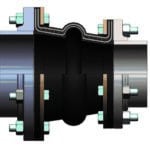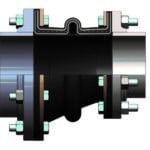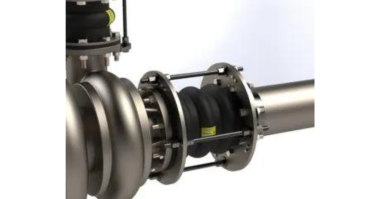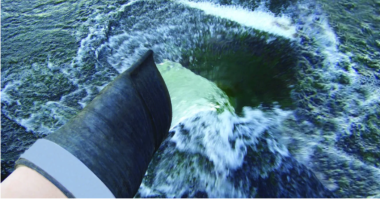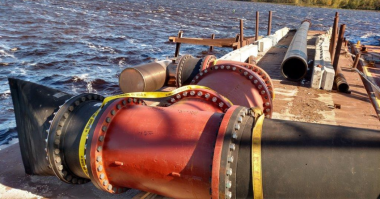Water and wastewater systems depend on complex pumping and pipe systems that can be greatly damaged in the event of failure.
Expansion joints have kept these systems protected from sudden movement related to vibration, pump thrust, earth movement, high or shifting temperatures, and improper anchoring since the 1930s. Originally, these were steel welded and button-type joints, but in the 1960s rubber joints became popular due to their abrasion resistance and flexibility.
Cal Hayes, General Manager, and Stacie Cummings, Waterworks/ProFlex™ Sales Manager for Proco Products, Inc. explain the capabilities and criticality of expansion joints. With over 40 years of experience between them, they share insights on how to prevent devastating failures.
The Experts
- Cal Hayes – General Manager, WaterWorks Division
- Stacie Cummings Sales Manager, ProFlex™/Waterworks
Q. Where are expansion joints typically located in the system?
Expansion joints are usually located close to pumps and elbows. One primary engineering concern is, what happens when a pump starts? Changes in pressure or flow direction can create cavitation and huge surges in the system, especially when solids are in the stream.
Q. What issues are important for blower piping applications?
One important issue is pressure. The other issue with blower systems is heat. Rubber bellows cannot withstand extreme heat. However, rubber expansion joints may still be usable depending on their distance from the blower and ambient temperatures.
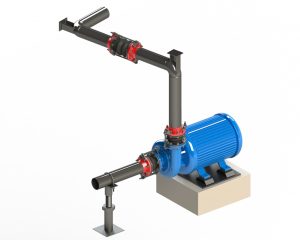 Q. What is the difference between an open arch versus a filled arch expansion joint?
Q. What is the difference between an open arch versus a filled arch expansion joint?
Expansion joints were originally designed with an open arch, where the bellows are unfilled. However, if heavy particles are in the media they can drop into the convolution. The flow pattern then spirals in the convolution causing abrasion at the top of the arch. This leads to failure of the expansion joint.
In a filled arch, the bellows are solid. A filled arch prevents the failure issues that occur when heavy solids are being pumped. Filled arches will also last longer as they are more resistant to abrasion.
To determine which type of joint is needed, the media’s specific gravity should be determined. An open arch expansion joint can usually be used for flows with a specific gravity of 1.2 or less. If 20% or more solids are being conveyed through the line, a filled arch is recommended. Note that a filled arch reduces the axial and lateral movements by half. Multiple arches can provide additional movements. An extra joint further in the pipe system can be added. In tight locations where longer or extra joints are not practical, Proco provides low profile expansion joints designed to enhance the joint’s ability to clear/flush itself.
Q. What materials are rubber expansion valves made of and how long do they last?
The design life on rubber expansion joints is phenomenal. Elastomers come in several different variations. Those include EPDM for water, nitrile and UM for sewer service, and natural rubber for mining. Different types of elastomers are also available for various chemicals. Proco can provide Teflon for acid service where rubber could never be used.
Q. What are some other concerns related to the use of expansion joints?
A major engineering issue is how to protect pipe and equipment in areas with seismic activity. Even areas where not prone to earthquakes may experience such problems in the future.
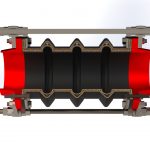 Proco provides an expansion joint called a lateral service (Proco 233L and 234L). These longer expansion joints with three or four convolutions are designed for lateral offset versus axial compression and extension. Lateral service joints can provide up to eight inches of lateral offset and are often used on bridge crossings, around dams, and any other areas of potential ground shift.
Proco provides an expansion joint called a lateral service (Proco 233L and 234L). These longer expansion joints with three or four convolutions are designed for lateral offset versus axial compression and extension. Lateral service joints can provide up to eight inches of lateral offset and are often used on bridge crossings, around dams, and any other areas of potential ground shift.
Q. What are Concentric and Eccentric Expansion Joint Reducers?
Pipe diameter changes are common in the design of pipe systems. In those cases, steel reducing spools are sometimes used along with a rubber expansion joint. However, this extends the length of real estate needed for a diameter change.
Proco offers concentric (RC) and eccentric (RE) expansion joint reducers. These have a different diameter on each end with the proper number of convolutions in the middle. RC joints are used on the discharge side and RE joints on the inlet side of a pump. RC and RE joints are a win-win for both the engineering firm and the utility, especially when there is limited space for pipe. RC and RE expansion joints reduce cost as well.
Q. What are the consequences of pipe movement beyond design criteria?
Consequences can be disastrous. The result can be public damage, where the pipe moved so much that it tears the flange off of the joint or extended to where the arch is torn apart. While public damage is dangerous, personal damage is worse. Employees or other people in the area can be hurt when pipe systems fail. As a solution, Proco offers and strongly suggests the use of control rods. These are a series of steel or stainless steel rods designed to prevent the joint from moving past its intended design. Threaded rods are fastened to the pipe flanges to prevent the joint from pulling apart. The Proco sales team is well trained to assist in these applications.
Proco works closely with engineers during design to recommend the types and locations of expansion joints. Proco is affiliated with the Fluid Sealing Association (FSA) where manufacturers listen to engineers and industry experts to learn about real life problems in the field and provide solutions.
Proco Products, Inc. is a global company. We have the ability and willingness to listen to our customers and can design special products when needed. Contact us for more information.




